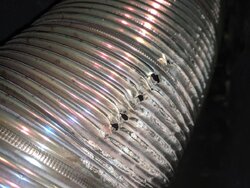So I had an insert that I was never really happy with and I bought a jotul castine from a nice old lady to replace it with. I've cleaned up the firebox a bit and was looking at shortening my flex liner to fit a new stove connector when I saw what looked like a few small perforations in the side of the liner. It was installed by a supposed pro who cut out some of the old damper frame to make room for the liner. No surprise but the holes are right above a very sharp square corner that they left. This was about 5 years ago. Now I'm stuck wondering if there is a safe way to patch this, if there is a way to cut off the damage and splice in a section as it's about 8" up from where the cut for my new connector will go, or if I need to replace the whole thing. Awaiting you expert advice
Ben
Ben



